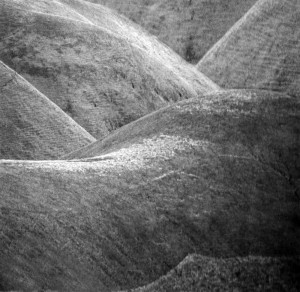The main theme of the 2005 conference was the creative process and the creation of artifacts: understanding creative practice, art works employing digital media and creativity support tools.

Cerebrum Surface (archival injet print), part of a series 'Irregular by Nature' exploring the external surface and texture of the brain
Abstract from my paper
“A Theory of Error explores notions of art and corporeality, and in particular art representing the brain and mechanisms of thought, reflections about exploring the creative process and considering thought when the brain is simulated through digital imaging. Forming a theoretical background to the project are various interwoven theories from cognitive psychology, neuroscience, art and technology that examine the mechanisms of creativity in relation to mutation and disorder, chaos and abstraction.” The papers of the conference appear at: http://portal.acm.org/portal.cfm
The program of the conference was separated into 3 streams: Central, scientific and technology orientated work on creativity; An expanded coverage of creative art practice; Historical development in this area.
The Art Component
The reflective practice and practice based research chaired by Janis Jefferies (Dept of Art, Goldsmiths College). The aim: “To provide a platform for a new type of a multi-disciplinary worker: the artist as researcher, participating in trans-disciplinary practices and pioneering research in the development of technologies at the cusp of creativity and cognition.” To further develop my research and to establish appropriate relations, this is exactly where I need to be.
The exhibition represented collaborative art projects from performance art, sound art, visual arts, musicians, technologists and scientists… presenting new models for engaging in and exploring the nature creativity. Interactive art & collaborative projects placed emphasis on the artist as “a node in the network of creativity” and the combination of thought matrices to develop a project was the strength in artistic practice and the creative process, whatever the discipline.
I was especially engaged in the art demonstration titled: Tech-tiles (Tim Blackwell & Janis Jefferies). The tech-tiles, visually, are rectangular portions of an image, and aurally, portions of a sonic event or stream. The whimsical sounds reacted to the density of textured image and various textural forms were created from spontaneous sounds mapping of textile images into sound. The association and correlations became both harmonic and disturbing sonic improvisation.
Society of Neurons: An Arts/Science Project (Warren Neidich, Robert Zimmer & Thibaud de Souza) was an interactive & interdisciplinary project and one of the most inspiring. Using current theoretical frameworks emerging out of neuro-scientific inquiry, a very lively web-based mutating computational network or a “web-brain” has been created. The frameworks were discussed further in a conference in May 05 titled: “Neuroaesthetics” chaired by Warren Neidich. And if you missed that one, you can find out more about his work at www.artbrain.org (including links to his new Journal of Neuro-aesthetic Theory) or his book: BLOW-UP: Photography, Cinema and the Brain (2003).
Workshop
Freedom & Constraint in the Creative Process in Digital Fine Art: an AHRB Invited workshop. Chaired by John Hayworth. Although I wasn’t officially on the list of attendees, John accepted me as a late participant due to the appropriateness of my work.
The workshop shed light on the freedom and constraints in creative process focusing on thought, technique and materials. Key points:
• the digital greatly influences our perceptions and approaches to creativity
• computer aided art manifests a diversity of practices in which the fusion of thought and action is critical to the creative process
• The computer extends creative ability to express interactive techniques and enables the viewer to have an active role and an immediate relationship with image making.
• The digital provides fluidity in image construction.
• Digital changes the way we are creative – enhancing the process and influencing the way we view the world. Technology influences perception and thinking; while at the same time concepts, ideas and feelings influence the use of technology.
• Rather than being called a “digital artist” we can say we are “informed by the digital”
Other Highlights
Another notable address was that of Keynote Speaker Margaret Boden (Research Professor of Cognitive Science at the University of Sussex). I had referenced Margaret throughout my Masters research and was delighted to hear her speak and to visit the new Dana Centre at the Science Museum. She spoke about new technologies, new aesthetics and new principles of aesthetics to evaluate interactive art and also presented several different ways of generating creative ideas – based on the following:
• Arranging existing ideas in new combination’s
• Taking accepted cultured styles and explore potential, extend limits tweak styles or utilise new tools
• Defining creativity as a transformative process, where the fundamental rules are altered… new structures (by mutations or otherwise). Examples were in major art movements or individuals and individuals who led them.
More tangible, technical measurable processes, where explored in many of the papers presented. Creativity was discussed in terms of computer functioning, computer programming and design. “Understanding Design as a Social Creative Process” (Andy Warr & Eamonn O’Neil) discussed creativity in respect to design and the emphasis being that social creativity is more productive than individual creativity. The landmark event of the “9 Evenings: Theatre & Engineering” 1966, was used as a source of historical reference into the nature of interaction and collaboration, creative dialogue and collective wisdom.
Thanks to ANAT and RMIT University. The opportunity to attend the conference and exhibit my art work/research to international audience has been an extremely valuable experience, mostly in terms of exposure to contemporary interdisciplinary thought in the pursuit of understanding the creative process.
 This work is licensed under a Creative Commons Attribution-NonCommercial-ShareAlike 2.5 Australia.
This work is licensed under a Creative Commons Attribution-NonCommercial-ShareAlike 2.5 Australia.






